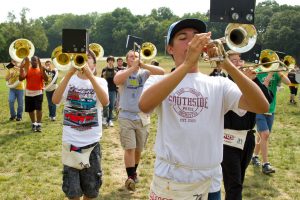Bands March to the Beat of a Different Schedule
 Opening Day 2013-14 for most DMPS schools, including all five of the comprehensive high schools, is Thursday, August 22, but lots of high school musicians got their marching orders long before then.
Opening Day 2013-14 for most DMPS schools, including all five of the comprehensive high schools, is Thursday, August 22, but lots of high school musicians got their marching orders long before then.
Band camp opened in early August to ensure that the halftime shows at football games are in midseason form right from the season’s opening kickoffs.
At Lincoln, directors Darin Bartachek and Kevin Stegemann welcomed more than 150 students, their biggest turnout yet in 11 years together at the school. If the sheer numbers alone weren’t enough to get them especially revved for the new season, there’s added excitement because this year, for the first time, they’ve commissioned a customized performance program for the music the marching Railsplitters have selected from Les Miserables. There’s a lyric from one of their selections that might be looping in some of the troops’ minds by the time they’re done with preseason drills.
Look down, look down
Don’t look ’em in the eye
Look down, look down,
You’re here until you die
Two-a-day sessions (8:00-11:30 A.M. and 1:00-3:00 P.M.) focus on the music in the morning (Bartachek) and the field maneuvers in the afternoon (Stegemann). Two-a-days is a term most commonly associated with football and it’s just one of the parallels between the two extra-curriculars besides the playing surface they share on fall Friday nights. Another is the blunt, get-to-the-point coach-speak that Bartacheck and Stegemann employ to get and hold the kids’ attentions during the crash course that will get them ready for their debut on August 23 at the Chicken Bowl, a longstanding fall fundraiser at Lincoln. Besides that event and their appearances at home football games, the marching band has its own season to prepare for. When they perform at competitions like the North Central Invitational and ValleyFest the band will present a program that lasts about 14 minutes and draws 52 “pictures.” We’re talking about walking and chewing gum simultaneously raised to an art form with the crispness of military precision.
Bartachek describes the marching band as a family and points to it as an important means of absorbing incoming freshmen into one of the state’s largest and potentially most intimidating high schools.
“The kids ‘geek’ this, they really do,” he said. “And by the time the first official day of school rolls around they’re already part of a group they can stay with for four years and have some good habits and routines that will carry over to whatever else they do.”
You can see and hear the continuity of the two directors’ long association when their band takes the field. To extend the football analogy even further, winning teams are roughly equal parts offense and defense. In this case, there’s the marching part and the band part. After all these years together the two mesh like a pair of hands. And they’re clapping with excitement at the prospect of their customized program.
“Usually bands just sort of subscribe to routines out of a box,” Bartacheck explained. “One year we were at a competition and another school there was doing the same program we were. But somebody Stegemann knew from college started a company that creates one-of-a-kind field presentations based on the music you select.”
The result is a complex looking set of charts that tells the trombone how it connects to the drum bone and everything else the trombone is supposed to connect to. Eventually the footwork’s gotta get memorized so the players can focus on the sheet music that’s clipped to their instruments and steal a glance at the drum major[s] out of a corner of one eye. But not yet – practicing the movements is one of the things that band camp’s for.
“One of my pet peeves during band camp is when nobody uses the charts that we worked so hard on,” Stegemann bellows from a hillside that gives him some perspective on the spacing of the whole unit, a jumble of moving parts that needs to become one and just then is standing still, at attention. “You get them on the first day and think you never have to look at them again, but all of you should be holding #7 in your hand!” he continues, as everyone reaches into the carpenter apron tied around their waist and fumbles for #7.
Give ‘em another week and they’ll have all the moves and notes down pat. They’ll be struttin’ their stuff in maroon and gold uniforms topped off with hats as fancy as their sparkling horns and when they break into the Lincoln Fight Song everyone will stand together and it will never have sounded better.




